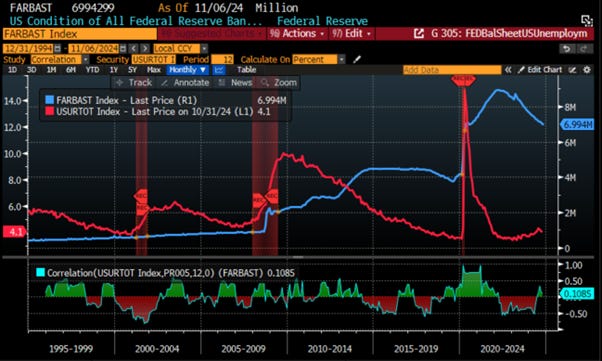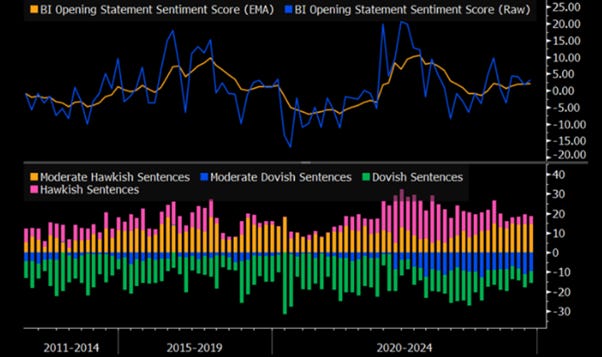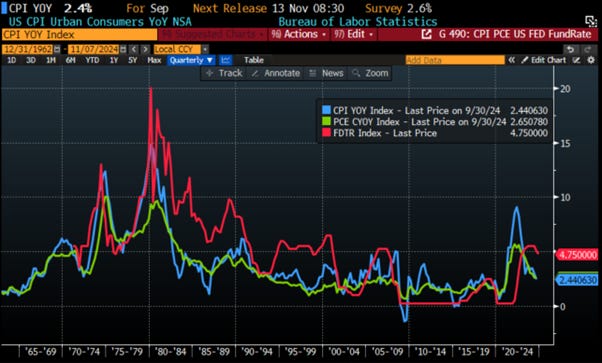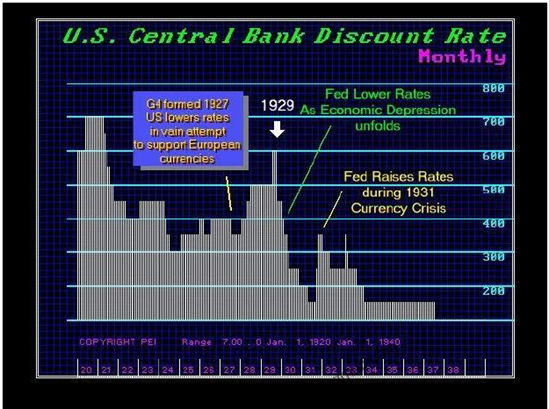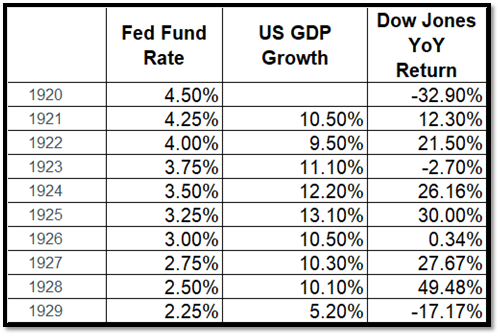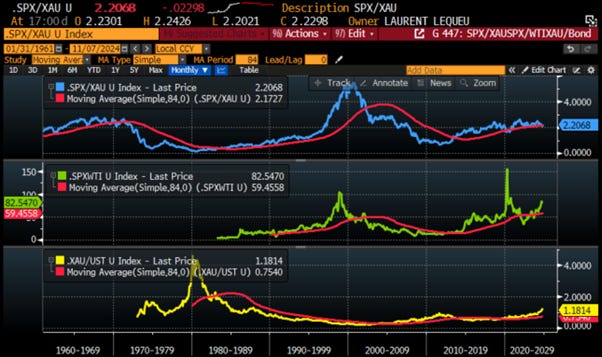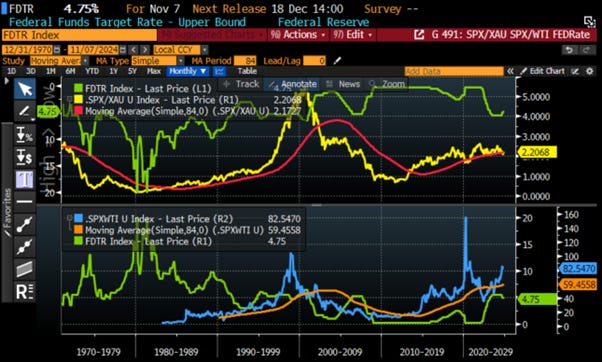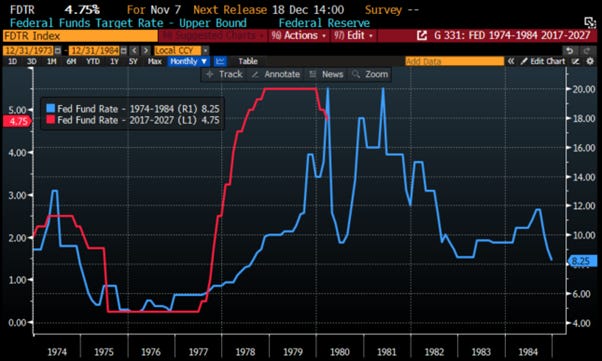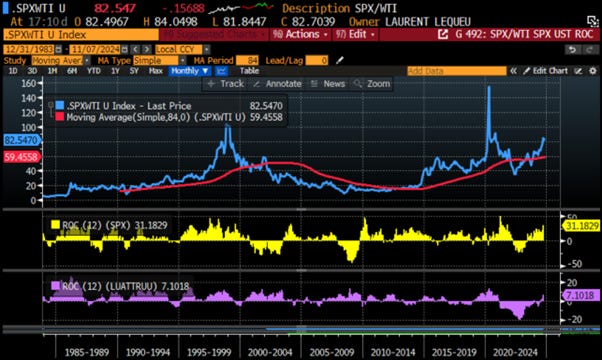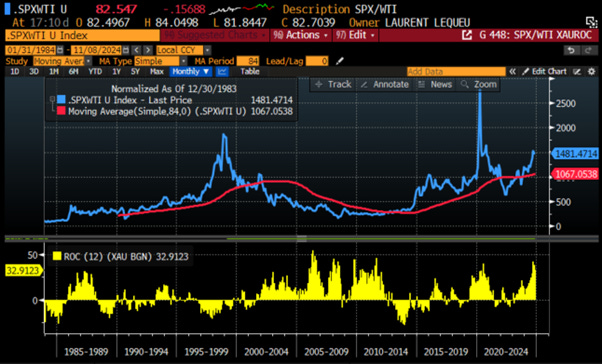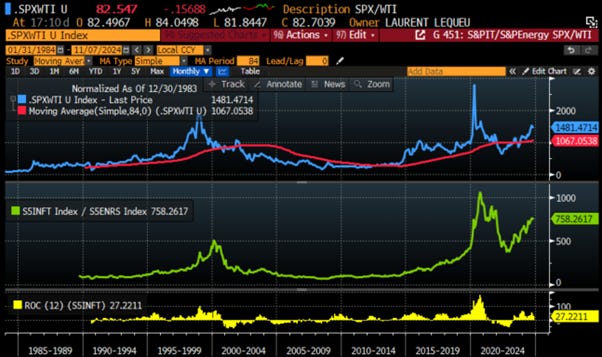Another irrelevant 25 bps cut…
What’s behind the numbers?
FED officials unanimously lowered the federal funds rate by 25 bps to a range of 4.5% to 4.75%. This second consecutive rate cut followed a larger half-point reduction in September, continuing efforts to keep the US economic expansion on solid footing.
In its press release, the FED highlighted that “this further recalibration of its policy stance will help maintain the strength of the economy and the labour market and will continue to enable further progress on inflation as it move toward a more neutral stance over time.
Regarding the impact of a new administration on monetary policy, Powell stated, ‘We don’t know what the timing and substance of any policy changes will be. We therefore don’t know what the effects on the economy would be, specifically whether and to what extent those policies would matter for the achievement of our goal variables: maximum employment and price stability.
The Federal Open Market Committee stated that it continues to see the risks to achieving its employment and inflation goals as ‘roughly balanced’.
The committee slightly adjusted its language regarding the job market as well. ‘Since earlier in the year, labor market conditions have generally eased, and the unemployment rate has risen but remains low,’ the FED statement said. Powell described the labor market as ‘solid.’
Regarding quantitative tightening, the FED’s process of allowing bond holdings to roll off its balance sheet without fully replacing them, Powell added during the press conference, ‘We are not considering stopping the runoff just because the FED is now cutting rates.’
FED Balance Sheet (blue line); US Unemployment Rate (red line); Correlation & US Recessions.
Powell emphasized that he will "wait and see the data" to determine if the four rate cuts expected in 2025 are supported by the economic indicators.
Powell's opening remarks indicated that his sentiment in the prepared comments was essentially unchanged from the September meeting. However, the FOMC minutes may reveal a more nuanced view, as more members are likely open to pausing at some point in the future.
Thoughts.
The FED's decision to cut rates once again may excite Wall Street bankers and YOLO investors, but the upward shift in the yield curve since the partisan driven September meeting reveals how impotent the FED has become in managing the economy, which is now in the hands of the bond vigilantes as fiscal dominance expands.
US Treasury Yield curve as of November 7th (green line); September 18th (orange line).

The yield curve matters more than the FED decision because everyone knows that in the US, mortgage rates, mostly fixed for a 30-year period, are indexed to the US 30-year Treasury yield. In this environment, while all Wall Street economists were excited about the positive impact of the FED cutting rates in September, the reality for average Americans trying to buy a home as part of the American dream is quite different. They have seen the cost of financing their dream homes increase since September, while banks remain hesitant to lend to borrowers. This has resulted in the largest spread between the US 30-year mortgage and the US 30-year Treasury yield being two standard deviations above its 25-year mean, a level that historically has preceded the US government to declare a recession.
Bankrate 30-year US Mortgage rate (blue line); US 30-Year Yield (red line); Spread between Bankrate 30-year US Mortgage rate and US 30-Year Yield (lower panel; histogram) & US Recessions.
By deciding to cut rates by an additional 25 basis points, the FED has effectively abandoned its ‘inflation mandate,’ as anyone with a minimum of common sense and understanding of how the base effect is working knows that the disinflationary illusion ended in September and that whatever happens on the geopolitical scene, investors and consumers who were also voters 2 days ago should get ready for reflation as the PCE will inevitably stay well above the FED target over the next 12 months.
US CPI YoY Change (blue line); FED Fund Rate (red line); US Core PCE YoY Change (green line).
Some investors may be surprised that the FED is cutting rates while the US economy is still in an inflationary boom. This isn't the first time the FED has done so during an economic boom. In 1927, the FED lowered US rates amid a booming economy, attracting more capital to the US as investors chased asset appreciation, notably in auto stocks, a trend comparable to the AI bubble of the 2020s. Interest rates were irrelevant; even the Florida land boom peaked in 1927 as capital flocked to stocks, the hot investment of the Roaring '20s.
Those who understand that the US economy is gradually shifting from an inflationary boom to an inflationary bust should not be surprised of the impotence of the FED. As the S&P/Gold ratio is bouncing around its 7-year moving average, a leading indicator, typically by 3 to 6 months, for a similar trend in the S&P/WTI ratio, which reliably signals a shift from economic boom to bust will understand that the action taken by the FED will not impact the trend in long dated yield as the USD (i.e., US Treasuries) remains a poor store of value compared to gold, the timeless and resilient store of value.
Looking at what the FED was forced to do historically when the S&P 500 to gold ratio broke below its 7-year moving average, such as between June 1971 and July 1983 or February 2002 and May 2013, pushing the S&P 500 to WTI ratio below its 7-year average a few months later, the FED has consistently been compelled to raise rates sooner rather than later to combat monetary illusion, ultimately leading to an economic bust. This suggests that if Powell and his PhD colleagues are genuinely committed to keep the USD, the world reserve currency, as a reliable store of value and therefore fighting inflation for the benefit of the American people, as proclaimed at every press conference, it seems inevitable that the FED will have to reverse course in 2025 and raise rates again, if only to maintain the appearance of not fully colluding with the Treasury to finance additional reckless government spending at the cost of increasingly entrenched inflation in the US economy.
Upper Panel: S&P 500 to Gold ratio (yellow line); 84-months Moving average of S&P 500 to Gold ratio (red line); FED Fund Rate (axis inverted; green line); Lower Panel: S&P 500 to WTI ratio (blue line); 84-months moving average of S&P 500 to WTI ratio (orange line); FED Fund Rate (axis inverted; green line).
Like in the 1970s, the FED has succumbed to the charms of Wall Street’s mermaids, tempting the central bank into an interest rate cut cycle that will inevitably bring the return of the inflation boomerang as soon as the political circus around the White House concludes. As in the 1970s, the FED will flip-flop on its monetary policy and will have to reverse into an interest rate hike cycle once all the political and partisan masks no longer need to be worn.
FED Fund Rate between 1974-1984 (blue line); FED Fund Rate between 2017-2027 (red line).
As the US economy heads slowly but surely into an inflationary bust, regardless of the FED's actions, investors should remember that in such an environment, neither stocks nor bonds provide a positive inflation-adjusted 12-month return once the S&P 500 to WTI ratio breaks below its 7-year moving average, which is anticipated by early 2025.
S&P 500 to WTI ratio (blue line); S&P 500 to WTI ratio 84-months moving average (red line); S&P 500 adjusted to inflation 12-months Rate of Change (middle panel; yellow histogram); Bloomberg US Treasury Total Return Index 12-month adjusted to inflation Rate of Change (lower panel; purple histogram).
While Powell has reiterated a ‘Mission Accomplished’ stance in the fight against inflation and effectively abandoned the 2% inflation target since his appearance at Jackson Hole this summer, investors should adjust their portfolios as the US economy gradually shifts from an inflationary boom to an inflationary bust. This shift is likely to be painful, especially for those holding long-dated bonds and overlooking gold as the only antifragile asset to include in their portfolios.
S&P 500 to WTI ratio (blue line); S&P 500 to WTI ratio 84-months moving average (red line); Gold priced in USD terms adjusted to inflation 12-months Rate of Change (lower panel; yellow histogram).
This will also be a painful period for investors who still follow the biased Wall Street narrative surrounding the climate change scam, which spreads the misleading message that they should buy dips in energy consumers and sell rallies in energy producers. Indeed, the opposite approach would be more appropriate as unloved and under-owned energy producers will outperform cherished and over-owned energy consumers in such an environment.
Upper Panel: S&P 500/WTI ratio (blue line); 84 months Moving Average of the S&P 500/WTI ratio (red line); Middle Panel: Relative Performance of S&P 500 IT sector to S&P 500 Energy sector (green histogram); Lower Panel: S&P 500 IT index 12-month rate of change (yellow histogram).
Read more and discover how to position your portfolio here: https://themacrobutler.substack.com/p/another-irrelevant-25-bps-cut
If this report has inspired you to invest in gold and silver, consider Hard Assets Alliance to buy your physical gold:
https://hardassetsalliance.com/?aff=TMB
At The Macro Butler, our mission is to leverage our macro views to provide actionable and investable recommendations to all types of investors. In this regard, we offer two types of portfolios to our paid clients.
The Macro Butler Long/Short Portfolio is a dynamic and trading portfolio designed to invest in individual securities, aligning with our strategic and tactical investment recommendations.
The Macro Butler Strategic Portfolio consists of 20 ETFs (long only) and serves as the foundation for a multi-asset portfolio that reflects our long-term macro views.
Investors interested in obtaining more information about the Macro Butler Long/Short and Strategic portfolios can contact us at info@themacrobutler.com.
Unlock Your Financial Success with the Macro Butler!
Disclaimer
The content provided in this newsletter is for general information purposes only. No information, materials, services, and other content provided in this post constitute solicitation, recommendation, endorsement or any financial, investment, or other advice.
Seek independent professional consultation in the form of legal, financial, and fiscal advice before making any investment decisions.
Always perform your own due diligence.



